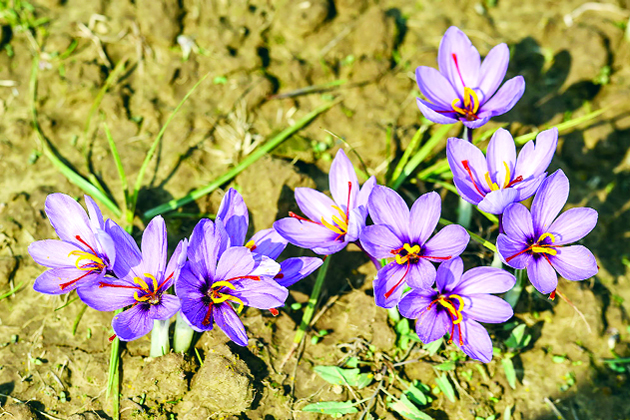Mohd Medhi
Kargil has an average elevation of 2,676 meters and is situated along the banks of the Suru River (Indus). It has a cool and temperate climate. Summers are warm with cool nights, while winters are long and very cold with temperatures often dropping to -20 to -30 °C. Most of the precipitation occurs as snowfall during the harsh and extremely long winter period. These winter snowfalls are of vital importance since they feed the glaciers which melt in the summer and provide most of the irrigation water as well as drinking water.
Saffron (Crocus sativus L.) “(family Iridaceae),” commonly known as red gold, is one of the most expensive and valuable spice crops in the world market. It predominantly contains chemical constituents such as crocin, picrocrocin, and safranal which are responsible for color, flavor, and aroma, respectively, and is highly valued for flavoring foods, dying textiles, medicinal applications,etc.
Even though successful attempts to grow saffron in other areas of India such as Uttar Pradesh and Himachal Pradesh have been reported as well as in Ladakh, almost all saffron production in India is limited to Kashmir. In Kashmir, saffron is grown on uplands (termed in the local dialect as ‘Karewas’), which are lacustrine deposits located at an altitude of 1585 to 1677 m above mean sea level, under temperate climatic conditions. If we look internationally at saffron production, countries like Iran and Afghanistan produce 90(%) of saffron all over the world. In Iran specially Khorasan Razavi province and Gonabad region are part of central Iranian plateau with arid and semiarid climates.
Ladakh has similar climate conditions to Iran and Afghanistan where saffron is grown. So to ensure the future of the saffron crop in Kargil we did some experiments which gave us very effective results as well as some space for improvement. The objective of the experiment is to explore the performance of saffron cultivation in Kargil and its future prospects.
Material and Methods
An experiment was carried out at Batsey Pa Nursery during the year 2023-2024 to evaluate the performance of the crop. The location of the experimental area is 13 km South of the district headquarters Kargil with an altitude of 2717 m (AMLS). The climate of Kargil is cold and temperate. The average annual temperature in Kargil is 7.5°C with 327 mm of precipitation. The driest month is November with 6 mm of precipitation. Most precipitation falls in March, with an average of 82 mm. The extensive diurnal and recurring fluctuations in temperature with -25? in winter and + 35 ? in summer.
For the first time cultivation of saffron in Kargil was started at the same location (Batsey Pa Nursery) way back in 2018 where we got some positive results with some sort of negative outcome. The positive result was that we were able to grow the crop and also get some flowers. On the other hand, corms were not able to survive the harsh winter conditions was a disappointing result. As time passed we made several attempts and finally, In the year 2023 we did the same experiment, but this time the corms were seeded at different depths under irrigated conditions.
The corms were brought from a progressive saffron grower in Pampore Kashmir. The size of the experimental area was 130 sq. feet with 3×16 feet beds each replicated thrice. A total of 520 corms were planted with a spacing of 20 cm × 10 cm (row to row X plant to plant) on 11th September 2023 and all the cultural practices needed to grow were followed.
Results
Climatic conditions play an important role in the cultivation of saffron. This time the survival percentage of the corms was 95%. The number of days taken for the first flowering was 50 days after sowing and the first harvest was taken on 53th days after sowing (3 November 2023) followed by 2nd harvest and 3rd harvest at an interval of 2 days. On average it took 165 flowers to get 1 gram of dry saffron. The average yield of saffron from a bed size of 48 square feet was 1.7 grams dry saffron which is a very good yield as compared to the Kashmir Valley which is 1.2 grams from the same area5. From the above result, it can be concluded that saffron cultivation has huge potential in Kargil and the quality analysis of the saffron from Kargil needs to be done. This crop has huge potential in the cold arid region of Kargil. More work needs to be done on the preservation of crom in harsh conditions (during winter).
(The author is a Forester in Kargil Forest Division, Ladakh)
Trending Now
E-Paper


